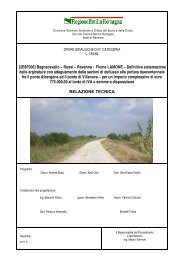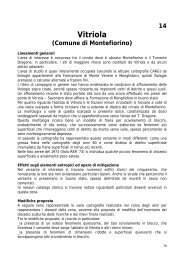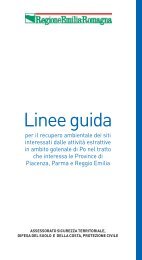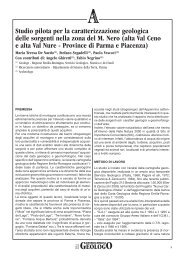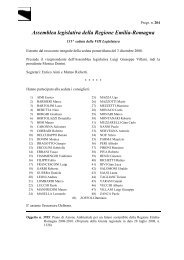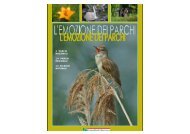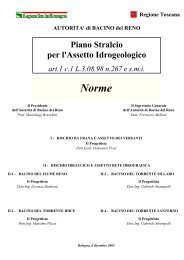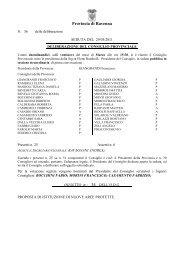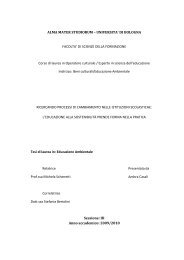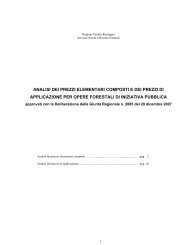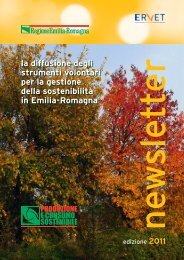air, water and soil quality qualité - ER Ambiente - Regione Emilia ...
air, water and soil quality qualité - ER Ambiente - Regione Emilia ...
air, water and soil quality qualité - ER Ambiente - Regione Emilia ...
Create successful ePaper yourself
Turn your PDF publications into a flip-book with our unique Google optimized e-Paper software.
This phenomenon is particularly evident in the vast plain areas of the Po River<br />
Valley, where as a result of urbanisation built-up areas now cover around 9% of the<br />
total l<strong>and</strong> surface; in some cases, along the Via <strong>Emilia</strong>, a major route, the figure<br />
exceeds 20% (Fig. 1).<br />
The present study took into account a surface area of approximately 650,000 hectares,<br />
including the coastal towns of the Po Delta area, from Melegnano to Ferrara.<br />
For the entire area, an evaluation was made of the patterns of urbanisation in the<br />
period between 1885 <strong>and</strong> 1995, while the subsequent analysis, aimed at a qualitative<br />
<strong>and</strong> quantitative determination of <strong>soil</strong> depletion, was limited to several areas<br />
within the region of <strong>Emilia</strong>.<br />
Methodology<br />
Farml<strong>and</strong> conversion trends were qualitatively <strong>and</strong> quantitatively evaluated in relation<br />
to urbanisation. The evaluation entailed a sequence of step.<br />
In the first stage, multi-temporal l<strong>and</strong> use maps were generated by means of a suitable<br />
geographical information system; different sets of mapping data on a scale of<br />
1:25,000 were overlaid <strong>and</strong> their relationship was analysed in order to evaluate<br />
urban development patterns <strong>and</strong> trends.<br />
The information used for this purpose was derived from the following sources:<br />
- topographic maps on a scale of 1:25,000, series 25V <strong>and</strong> 25N of the Italian<br />
Military Geographic Institute (IGMI), referring to the periods 1885-1890,<br />
1933-1969, 1980-1995;<br />
- technical maps on a scale of 1:25,000 <strong>and</strong> 1:10,000 of the Regions of <strong>Emilia</strong>-<br />
Romagna, Lombardy, Piedmont <strong>and</strong> Veneto, referring to the period 1985-1995;<br />
- aerial surveys of the IGMI (GAI survey flight–1954/55) <strong>and</strong> the General Aerial<br />
Photography Company of Parma (Italy survey flight – 1994);<br />
- municipal boundaries defined on the basis of the databank of the Po River Basin<br />
Authority.<br />
The second stage consisted in a pedological evaluation of the study areas; the information<br />
used for this purpose was retrieved from the databank of the Region of<br />
<strong>Emilia</strong>- Romagna (www.gias.net).<br />
Using GIS procedures, the map of urbanisation patterns obtained in the first stage<br />
of the study was compared with the <strong>soil</strong>s map. In this manner it was possible to<br />
assess net <strong>soil</strong> depletion directly in relation to urban expansion occurring within<br />
these areas. The agronomic characteristics of the <strong>soil</strong>s thus diverted from other uses<br />
were likewise analysed. This enabled a qualitative assessment of <strong>soil</strong> depletion; the<br />
resulting information may be usefully exploited by policymakers to improve l<strong>and</strong>planning<br />
tools so as to ensure more prudent use <strong>and</strong> promote conservation.<br />
In the initial stage of the project, the urban boundaries existing in the periods 1885-<br />
1890, 1955-1960 <strong>and</strong> 1990-1995 were manually traced on non-deformable transparent<br />
film. This support was first calibrated on the frame on a scale of 1:25,000 of<br />
respective geographic attribution <strong>and</strong> adjusted on the basis of regional technical<br />
maps (CTR) for the period 1990-1995 <strong>and</strong> the IGMI map for the period 1885-1890.<br />
208



